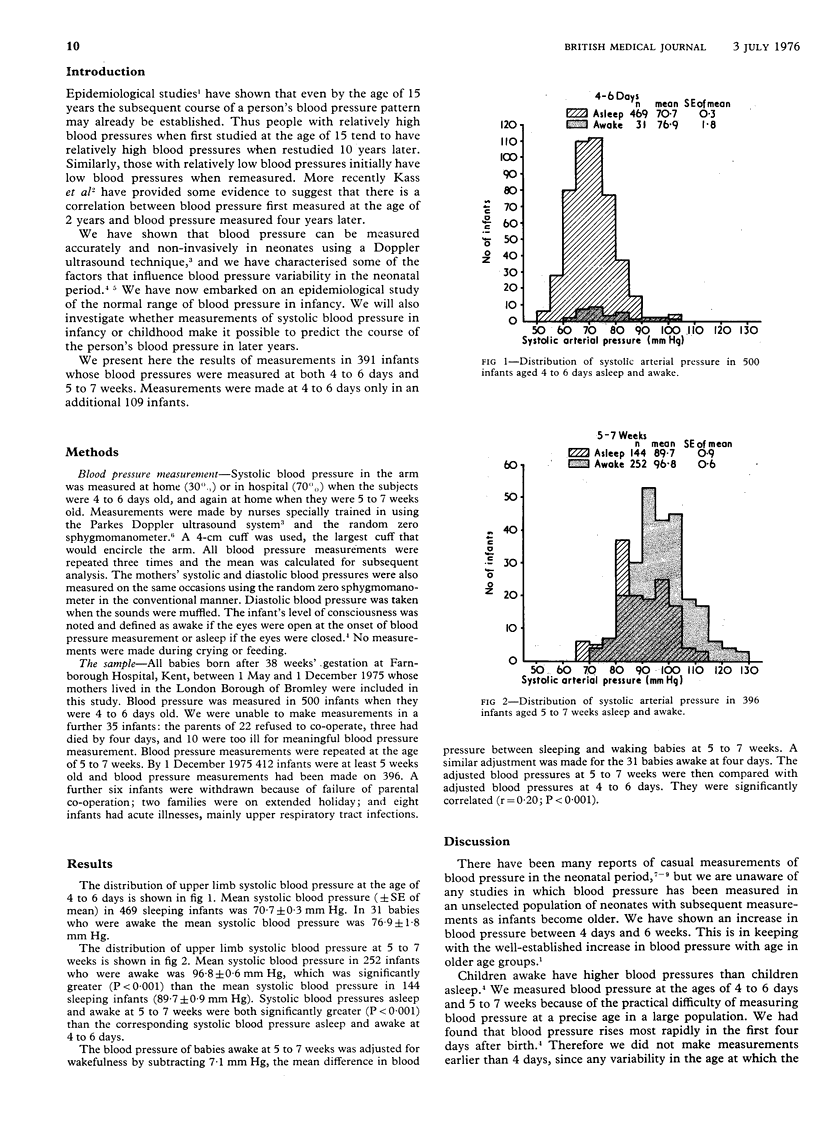Abstract
Systolic blood pressure in the arm was measured in infants at the ages of 4 to 6 days and 5 to 7 weeks by the Doppler ultrasound technique. At the age of 4 to 6 days the mean blood pressure (+/- SE of mean) in 469 sleeping infants was 70-7 +/- 0-3 mm Hg, rising at 5 to 7 weeks to 89-7 +/- 0-9 mm Hg (in 144 infants). In 252 infants awake at 5 to 7 weeks blood pressure was 96-8 +/- 0-6 mm Hg. In 391 infants in whom measurements were made on both occasions blood pressure at 4 to 6 days was significantly related to blood pressure at 5 to 7 weeks. Thus those infants with relatively high blood pressures at 4 to 6 days showed a weak tendency to have relatively high blood pressures at 5 to 7 weeks. In this trend continues with age it would suggest that the tendency to develop hypertension may already be demonstrable at the age of 4 to 6 days.
Full text
PDF


Selected References
These references are in PubMed. This may not be the complete list of references from this article.
- De Swiet M., Fancourt R., Peto J. Systolic blood pressure variation during the first 6 days of life. Clin Sci Mol Med. 1975 Dec;49(6):557–561. doi: 10.1042/cs0490557. [DOI] [PubMed] [Google Scholar]
- Elseed A. M., Shinebourne E. A., Joseph M. C. Assessment of techniques for measurement of blood pressure in infants and children. Arch Dis Child. 1973 Dec;48(12):932–936. doi: 10.1136/adc.48.12.932. [DOI] [PMC free article] [PubMed] [Google Scholar]
- Kannel W. B., Gordon T., Schwartz M. J. Systolic versus diastolic blood pressure and risk of coronary heart disease. The Framingham study. Am J Cardiol. 1971 Apr;27(4):335–346. doi: 10.1016/0002-9149(71)90428-0. [DOI] [PubMed] [Google Scholar]
- Kirkland R. T., Kirkland J. L. Systolic blood pressure measurement in the newborn infant with the transcutaneous Doppler method. J Pediatr. 1972 Jan;80(1):52–56. doi: 10.1016/s0022-3476(72)80452-9. [DOI] [PubMed] [Google Scholar]
- MOSS A. J., ADAMS F. H. FLUSH BLOOD PRESSURE AND INTRA-ARTERIAL PRESSURE. A COMPARISON OF METHODS IN INFANTS. Am J Dis Child. 1964 May;107:489–491. doi: 10.1001/archpedi.1964.02080060491009. [DOI] [PubMed] [Google Scholar]
- Modanlou H., Yeh S. Y., Siassi B., Hon E. H. Direct monitoring of arterial blood pressure in depressed and normal newborn infants during the first hour of life. J Pediatr. 1974 Oct;85(4):553–559. doi: 10.1016/s0022-3476(74)80469-5. [DOI] [PubMed] [Google Scholar]
- Wright B. M., Dore C. F. A random-zero sphygmomanometer. Lancet. 1970 Feb 14;1(7642):337–338. doi: 10.1016/s0140-6736(70)90709-9. [DOI] [PubMed] [Google Scholar]
- de Swiet M., Peto J., Shinebourne E. A. Difference between upper and lower limb blood pressure in normal neonates using Doppler technique. Arch Dis Child. 1974 Sep;49(9):734–735. doi: 10.1136/adc.49.9.734. [DOI] [PMC free article] [PubMed] [Google Scholar]


